Digoxin (Lanoxin)
D- dig level 2ng/ml or greater is toxic
I- inhibits sodium potassium ATPase
G-GI or CNS signs indicate adverse effects (N/A for adult toxicity, stomach upset in older child
O-output, intake, and weight should be monitored
X- dont give if pulse is less than 60 bpm
I- indicated for CHF- a-fib
N- note K+, ECG, and renal function tests
Epinephrine
N- nervousness (undesirable effect)
A- angina, arrhythmia (undesirable)
S- sugar is increased
C- cardiac arrest
A- allergic reaction
R-respiratory bronchodilator
norepinephrine (levophed)
S- stim alpha and beta adrenergic receptors
H- hypovolemia- should be corrected before using drug
O- output of urine should increase
C- constriction of blood vessels
K- keep monitoring vital signs every 5-15 min
nitroglycerin
A- avoid alcohol
N- note BP and apical pulse before admin
G- given to relax the vascular smooth system
I- indicated for angina pectoris
N-note for postural hypotension; rise slowly
A- advice client to see medical assistance if pain is unrelieved after 3 doses with 5 min interval
ACE INHIBITORS
S- suppresses renin angiotensin aldosterone system
W- warn clinet with renal or thyroid diseases
E- ends with pril- captopril (capoten) enalapril (vasotec)
R- rise slowly to reduce orthostatic hypotension
T- treatment of htn
E- evaluate BP
Beta- adrenergic blockers
end in lol- atenolol (Tenormin)
B- bradycardia
B- blood pressure too low
B- bronchial constriction
B- blood sugar is masked when low
Calcium channel blocker
amlodipine (norvasc), diltiazem (cardizem), nifedipine (procardia)
B- blocks calcium access to cells
I- indicated for htn
L- let client take drug with milk or meal
L- light and moisture- protect
Diuretics
D- diet; increase K+ for all except aldactone
I- intake, output, daily weight monitoring
U- undesirable effects- F&E imbalance
R- review HR, BP, and electrolytes
E- elderly careful, evening dose not recommended
T- take with or after meals and in AM
I- incrase risk of orthostatic hypotension, move slowly
C- cancel alcohol and cigs
warfarin (coumadin)
monitor?
antidote?
what food should be avoided?
prothrombin time is monitored 1.5-2.5 X control is the therapeutic range
Vit K is the antidote
Green leafy veg should be avoided
warfarin
C- check vital signs, platelte count, and PT
O- observe bleeding
R- review bleeding protocol
A- avoid ASA, may use acetaminophen
heparin sodium
PTT must be monitored 1.5-2.5 X control
Antidote is protamine sulfate
hospitalization is required for IV heparin
Clopidogrel (PLAVIX)
B- bleeding, brochospasms- undesired effects
L- lowers risk of atherosclerotic events
E- evaluate bruising
E- evaluate liver function
D- do take with food or after meals
HMG CoA inhibitors
competitive inhibitors of HMG-COA reductase, an enzyme necessary for cholesterol biosynthesis
indicated for hypercholesterolemia
atorvastatin (lipitor), simvastatin (zocor)
HMG COA inhib pneumonic
S- statin is the ending
T- take with food and at bedtime
A- always consume 2-3 L of fluid daily
T- teach client to do exercise and weight reduction as well
T- treat hypercholesterolemia
I- increase fiber in diet
N- never give if with liver disease
Antibiotics pneumonic
M- monitor superinfections
E- evaluate renal/liver function
D- diarrhea- take yogurt
I- inform provider prior to taking other meds
C- cultures prior to initial dose
A- alcohol is out, ask about allergy
T- take full course
E- evaluate cultures, WBC, temp, blood
Aminoglycosides
end in mycin
*serious infections caused by gram- negative infections
Allopurinol
G- gulp 10-12 glasses of fluid daily, GI distress (undesirable effect)
O- output and input monitor closely
U- uric acid production decreased, use no alcohol
T- take after meals
Phenytoin (dilantin)
G- gingival hyperplasia
U- use alternate birth control
M- mouth care; preventative dental check up
S- soft toothbrush don't stop abruptly
Lithium pnuemonic
L- level therapeutic 0.6-1.2 meq/l
I-increased urination
T- thirst increased
H- headache and tremor
I- increase fluids
LIDOCAINE pneumonic
(antiarrhythmic drug- subclass 1B)
L- local anasthetic
I- ICU popular antiarrythmic
D- digitalis toxicity used
O- orally inactive
C- cinetidine+ propanolol
A- decrease Automacity
I- inactivated Na Channel blocker
N- nystagmus
E- eye blurred vision, ECG change
You have 1 heart and 2 lungs":
Beta-1 are therefore primarily in the heart.
Beta-2 primarily in the lungs.
Anti-Epileptic Side Effect
ABCDEFGH
A taxia
B lood dyscrasia
C left lip
D upuytrens / Vit D deficiency
E xfoliation of skin & Stevens Johnson's
F its
G I upset/gum hypertrophy
H epatitis/hairy
Barbiturate Side Effects
ABCD
A taxia
B ehavioral disturbance
C oncentration decreased/coma
D epression/drowsy/diplopia
ACE Inhibitor Side Effects
CAPTOPRIL
C ough
A naphylaxis
P alpitations
T aste
O rthostatic hypotension
P otassium elevated
R enal impairment
I mpotence
L eukocytosis
SIDE EFFECTS OF CORTICOSTERIODS;
(CORTICOSTEROIDS)
C-cushings syndrome
O-osteoporosis
R-retardation of growth
T-thin skin n easy brusibility
I-infections n immunosupression
C-cataract n glaucoma
O-odema
S-supression of HPA axis
T-thining n ulceration of gastric mucosa
E-Emotional disturbance
R-rise in BP
I-Increase in hair growth(hirsuitism)
O-otherz like fetal abnormalties n hypokalemia
D-diabetes mellitus precipitation
S-stria
Drugs for heart failure-
< 3 D's for heart
failure >
Digoxin,
Diuretics,
Dilators
Respiratory Depression Inducing drugs
STOP breathing":
Sedatives and hypnotics
Trimethoprim
Opiates
Polymyxins
TB treatment
If you forget your TB drugs, you'll die and might need a PRIEST":
Pyrazinamide
Rifampin
Isoniazid (INH)
Ethambutol
STreptomycin
Drugs to treat viral respiratory infections
"You'd get a respiratory infection if you shoot an ARO (arrow) laced with viruses into the lungs":
ARO:
Amantadine
Rimantadine
Oseltamivir
Atropine
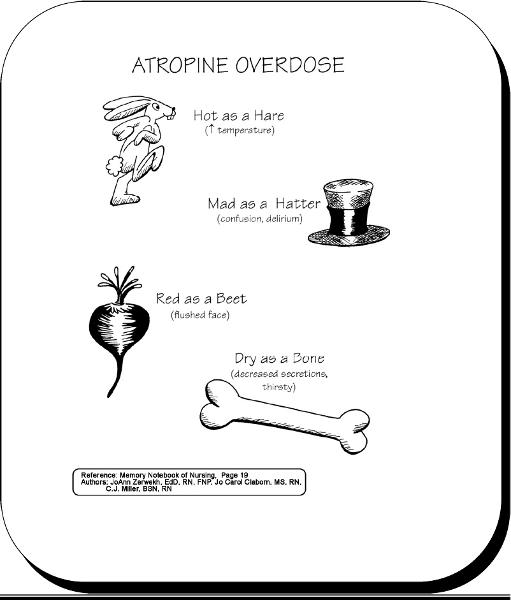
emergency drugs to LEAN on
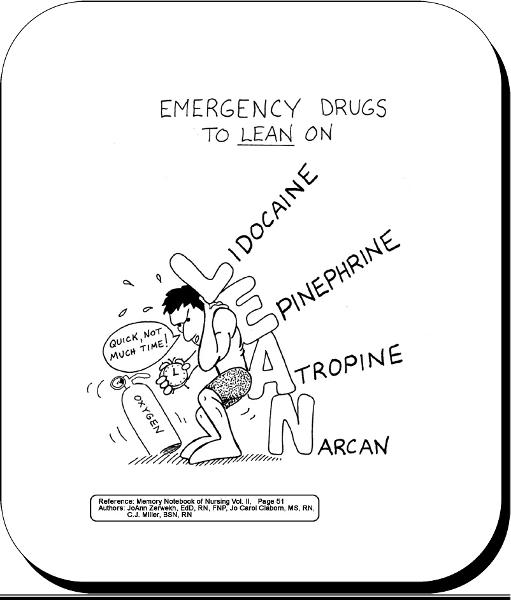
Drugs for Bradycardia and decreased BP
(IDEA)
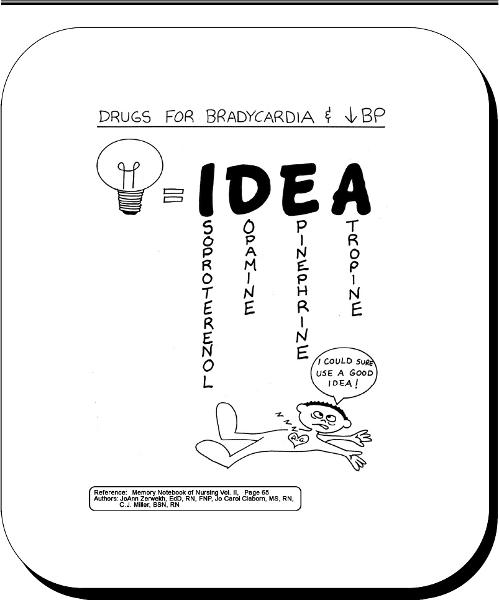
Cholinergic crisis- SLUD
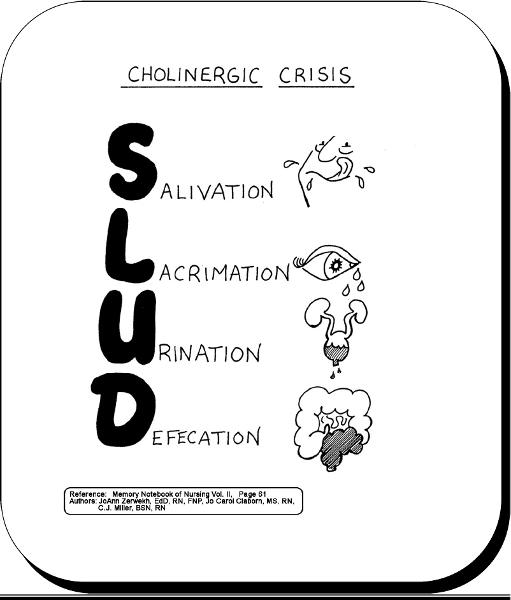
Beta Blocker Actions
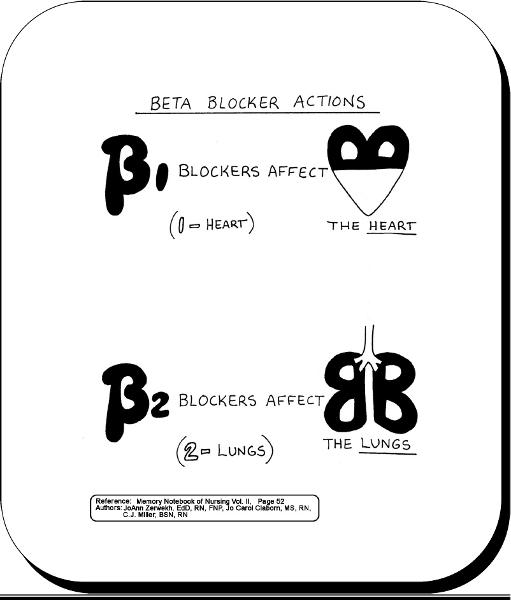
Anticancer drugs
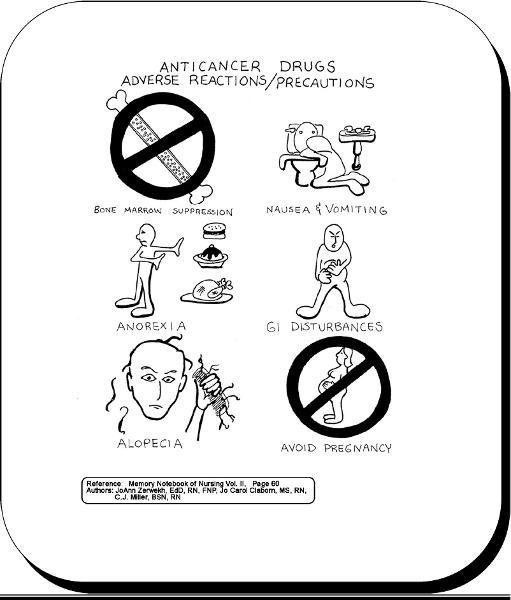
These drugs can interact (TDCI)
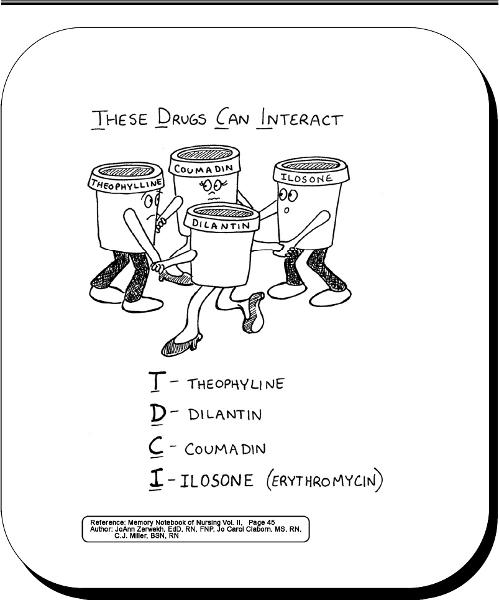
aminoglycoside toxicity
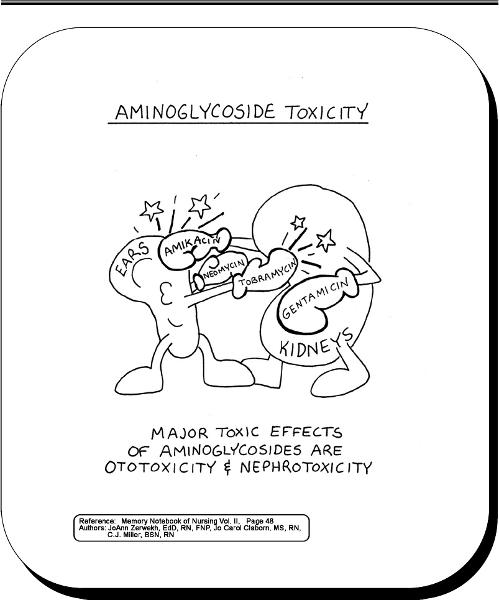
Quinalones and Tetracyclines ok in pregnancy???
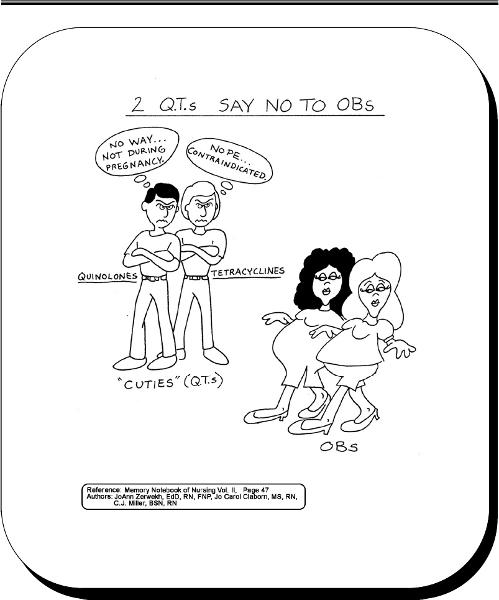
SE of adrenergic antagonists
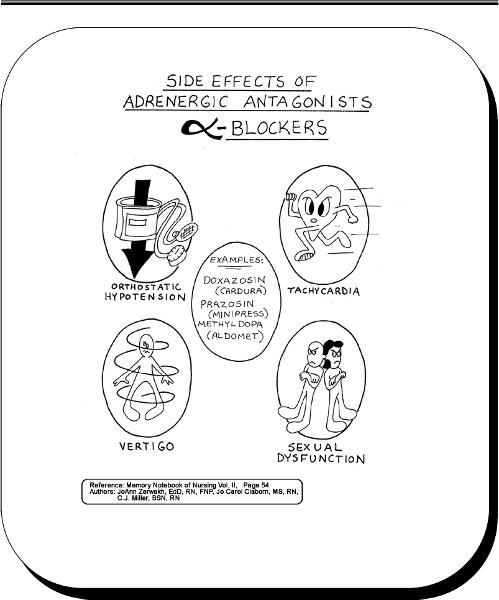
Lidocaine Toxicity
SAMS
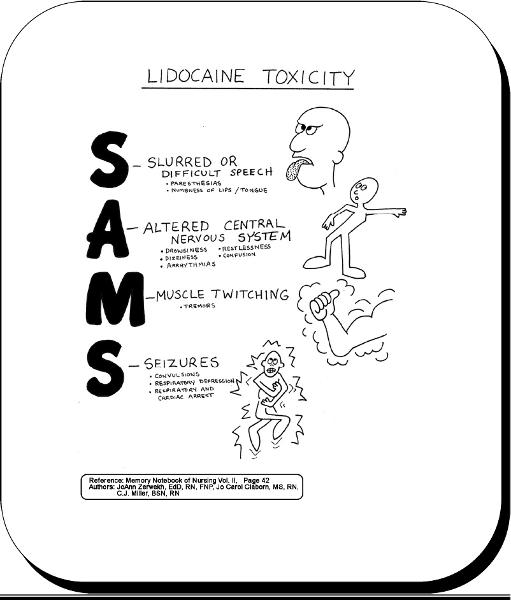
B6 relationship to INH and levadopa?
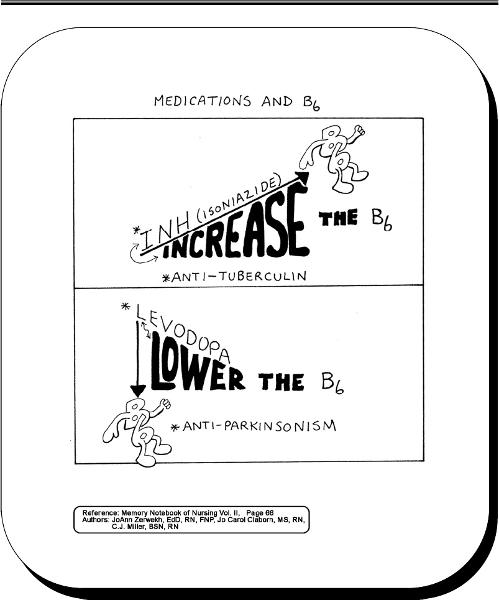
Mixing insulin
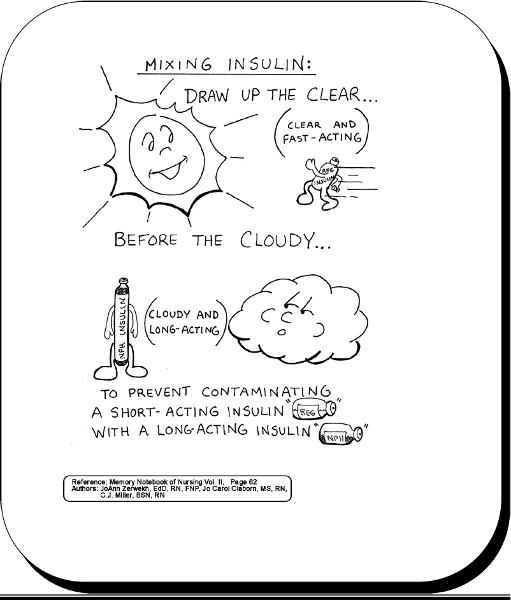
antiinflammatory
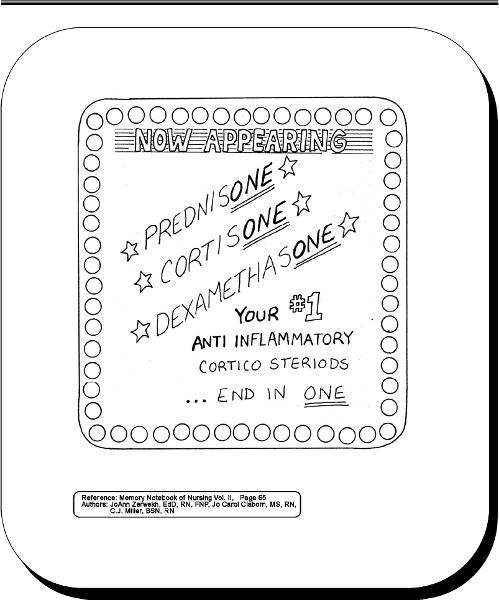
salicylate poisoning
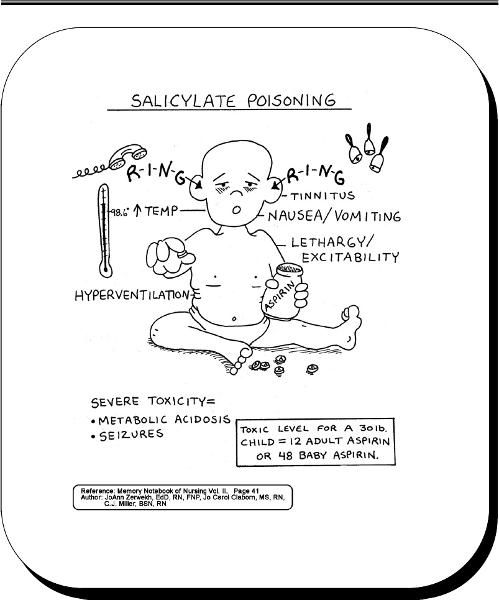
SASH technique
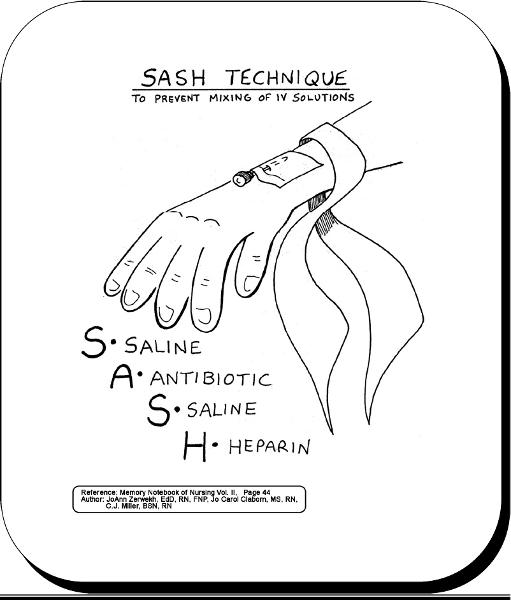
serious complications of oral birth control pills
(ACHES)
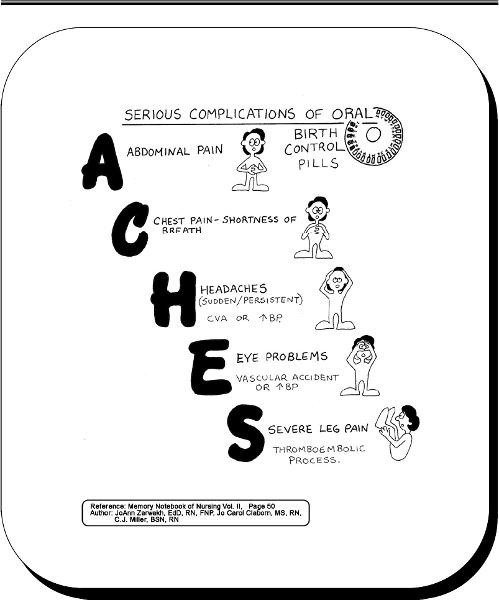
saw palmetto
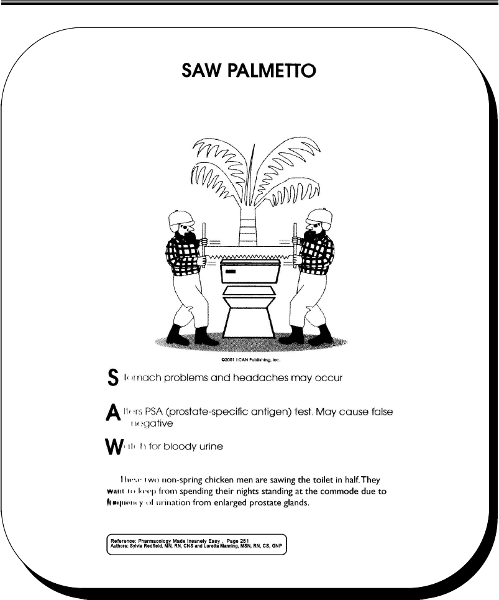
stomach problems
alters PSA
watch for bloody urine
ginko
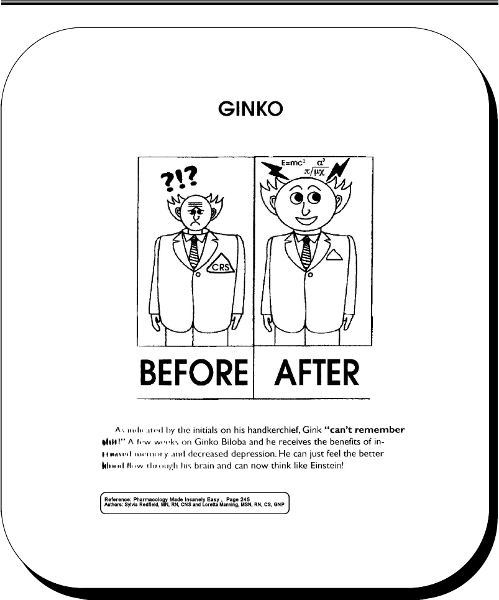
before couldn't think well.. now can think better!
Potassium
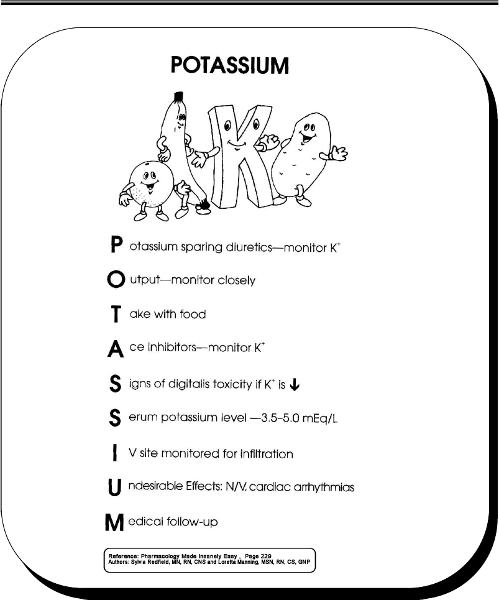
estrogen
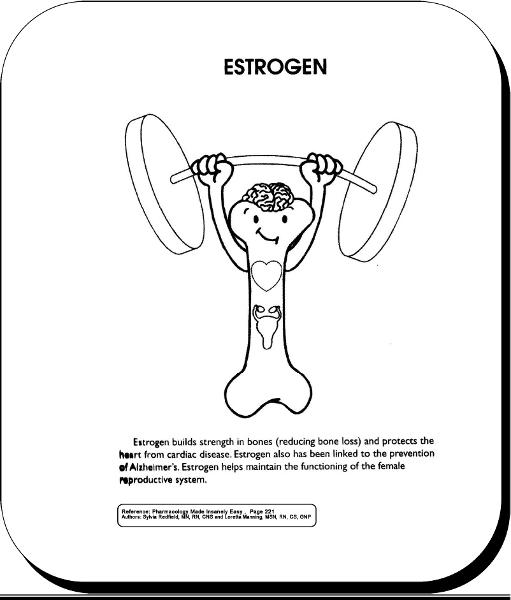
Bipolar clown image
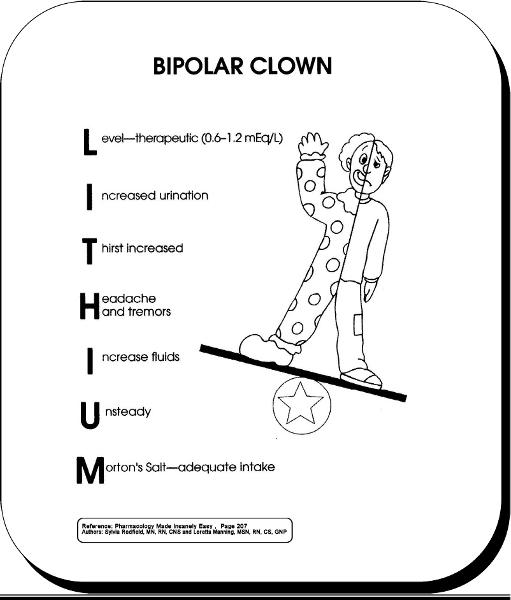
Buspar
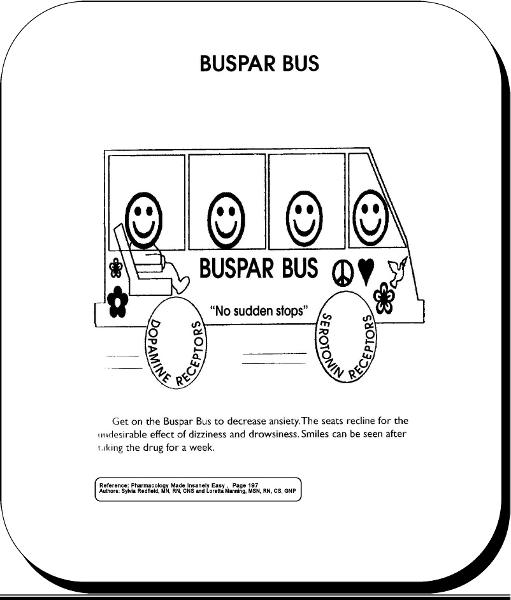
Dueteronomy
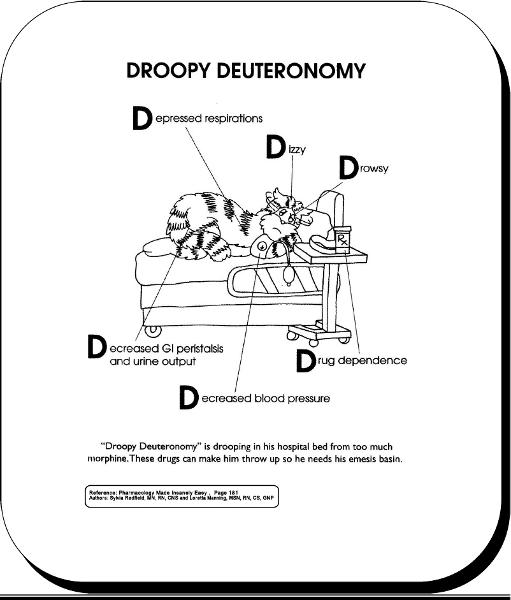
miotics
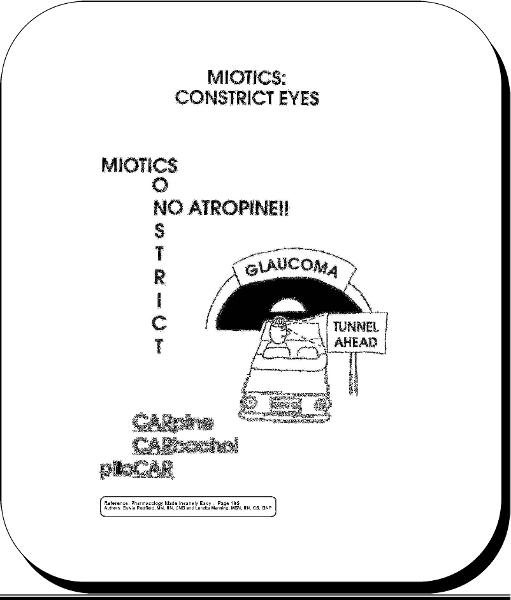
insulins and onset
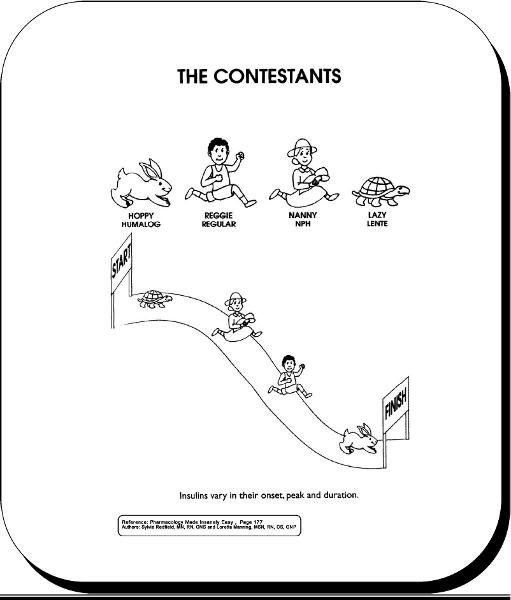
metformin
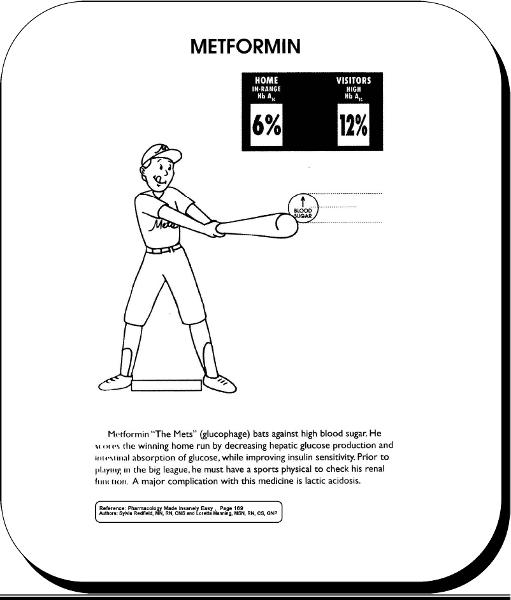
a major complication with this medicine is lactic acidosis
cushing
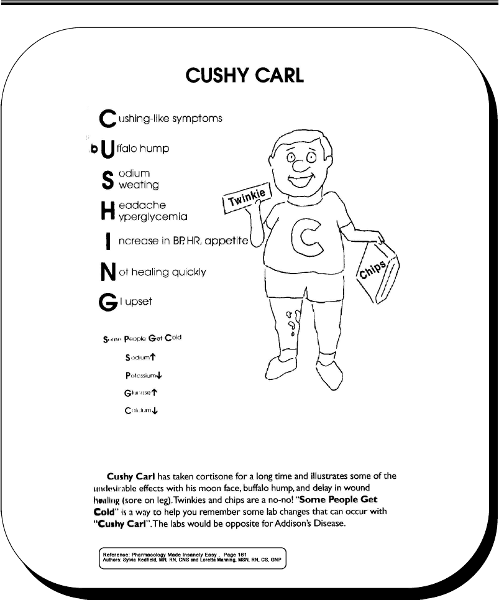
synthroid
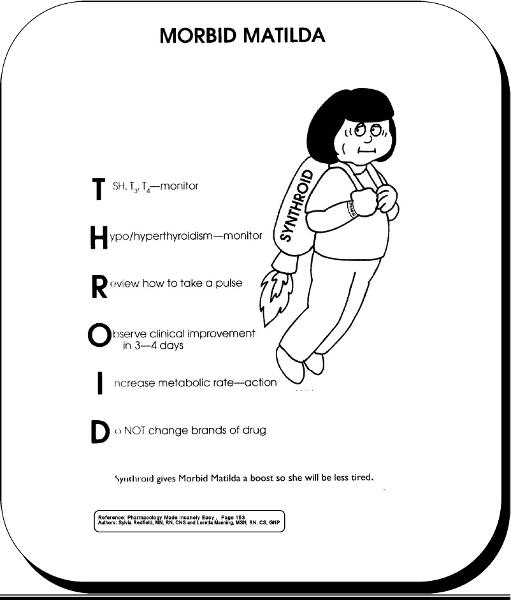
PTU
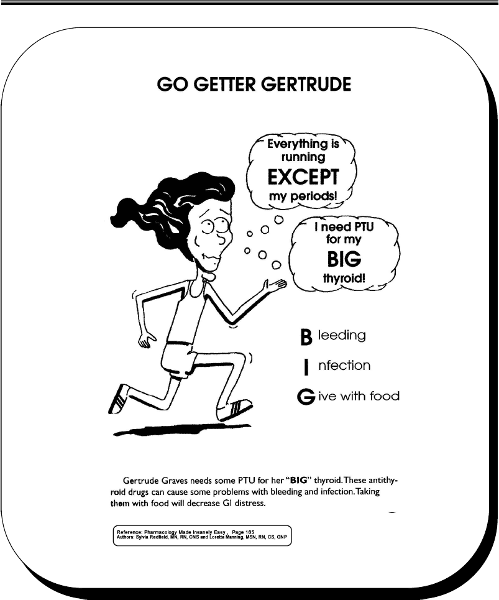
tuberculin syringe has the capacity of?
0.5 ml
Drug label should be read?
3 times
patch testing
identify sensitivity to contact materials such as soap, pollen, and dyes.. allergen on patch is placed in contact with back, arms, or thighs. Patch is left in place for 48 hours. Site is aired for 15 min, then read. Wheal is the definitive reaction measured from 1+ to 4+. Emergency equipment must be available in case of anaphylaxis.
after applying eye drops how long do you hold pressure to the inner corner of eyelid?
1-2 min
how to put in ear drops for child younger than 3
down and back
*older than 3 up and back
They should remain in position for a few min after application
MDI meds should be shaken?
vigorously 5-6 times prior to use. The client may position her mouth around the device or 2-4 cm in front of mouth
DPI (dry powder inhalers)
not to be shaken, and the client should place the mouthpiece between lips.
*For DPI and MDI client should exhale and then inhale the med deeply through the mouth for 3-5 sec and then hold breath for 5-10 sec.
why might a spacer be attached to an MDI
the spacer keeps the med in the device longer and thereby facilitates delivery of the med to the lungs and decreases the amount of med deposited in the oropharynx. This is beneficial for the delivery of glucocorticoids
after applying ear drops apply pressure to the?
tragus of the ear with finger
how are suppositories stored?
refrigerated! Remove foil wrapper and lubricate supposiory if needed. Instruct client to retain med and not expel it. Rectal suppositories are insterted beyond the internal sphincter and vaginal suppositories are inserted with an applicator.
Intramuscular route
used for irritating meds, solutions in oils, and aqueous suspensions.
common sites are the ventrogluteal, dorsogluteal, deltoid, and vastus lateralis (peds).
needle gauge 22-25, 18-27 needle size
1 1/2 inch long and inject 90 degree angle.
volume injected IM route
1-3 ml. If a greater amount is required it should be divided into 2 syringes and two different sites should be used.
z-track
prevents medication from leaking back into subcutaneous tissue
used for meds that cause visible or permanent skin stains such as certain iron preps
Intradermal
tuberculin testing or checking med/allergy sensitivities
may be used for cancer immunotherapy
small amount of solution 0.01-0.1 ml in a tuberculin syringe with a fine gauge needle 26-27 in lightly pigmented, think skin, hairless site. 10-15 degree angle
Time release capsules crushed?
They should not be crushed or diluted as med will be absorbed at a faster rate than recommended.
When should a breastfeeding mother take medication to ensure the least amount is recieved by the infant?
immediately after breastfeeding so this will minimize med concentration in the next feeding
Instilling vag meds
pt in lithotomy position, elevate hips with pillow
remain in position for 5-10 min after application
wash applicator with warm soapy water after each use.
antimicrobials
treat bacterial, viral, and fungal infections
narrow spectrum antibiotics
are effective against a few species of microorganisms such as gram positive cocci, gram positive bacilli, and gram neg aerobes
broad spectrum antibiotics
effective against a wide variety of microorganisms
what should be collected prior to antimicrobial therapy
specimens for a culture and sensitivity test
prescribed antimicrobial meds should be taken with what freq?
around the clock to maintain therapeutic blood levels
adverse reactions to antimicrobials
rash
anaphylaxis
suprainfection
organ toxicity (nephrotoxicity and ototoxicity)
decrease oral contraceptives effectiveness
how do penicillins destroy bacteria
weaken the bacterial cell wall
penicillins are the choice for?
gram + cocci such as streptococcus pneumonia (pnuemonia and meningitis)infectious endocarditis, streptococcus pyogenes (pharyngitis)
penicillins are also med of 1st choice for
meningitis - gram neg cocci and for treatment of syphillus
should penicillin and aminoglycosides be mixed in same intravenous solution
no, b/c penicillin inactivates aminoglycosides when mixed in same IV solution
nurse gives penicillin, what should nurse watch for?
observe client 30 min following admin of parenteral penicillin
monitor clients kidney function and cardiac and electrolyte status
________ are beta lactam antibiotics sim to penicillins that destroy bacterial cell walls causing destruction of the micro-organism
cephalosporins, grouped into 4 generations. they are broad spectrum with a high therapeutic index that treat UTI, post op infections, pelvic infections, and meningitis
clients should take oral cephalosporins with?
food, oral cephalosporin suspensions should be stored in the refrigerator.
bacteriostatic
prevent bacteria from reproduction
carbapenems
meropenem, beta lactam antibiotics that destroy bacterial cell wall
effective for serious infections like pneumonia, peritonitis, and uti cause by gram positive cocci, gram neg cocci and bacilli, and mixed aerobic and anaerobic bacteria.
monobactams- vancomycin
beta lactam antibiotics destroy bacterial cell wall
*drug of choice for serious infections caused by methicillin resistant staph and c-diff
vancomycin peak blood levels should be collected?
1-2 hrs after completion of IV infusion. Appropriate peak levels are between 30-40 mg/ml
how do we evaluate vancomycins effectiveness?
clear breath sounds, wound healing, improvement of sx of antibiotic associated pseudo colitis symptoms such as resolution of diarrhea and negative stool cultures for c-diff.
Tetracyclines (sumycin)
other meds- doxycycline. Broad spectrum antibiotics that inhibit microorganism growth by preventing protein synthesis (bacteriostatic). Tx acne. 1st line med for rickettsia (rocky mountain spotted fever, typhus fever, infections of urethra or cervix caused by chlamydia, lyme disease, anthrax, GI infections caused by h.pylori and periodontal disease.
avoid giving tetracycline to?
children under 8, yellow/brown tooth discoloration
avoid taking it at bedtime to reduce the risk of esophageal ulceration
taking tetracycline with milk/calcium/mag/antacids
should take tetracyclines at least 1 hr before and 2 hr after taking food and supplements containing calcium and mag
Tetracyclines should not be given with food except for?
doxycycline and minocycline
Bacteriostatic inhibitors
erythromycin, clindamycin, axithromycin, etc
slows the growth of microorganisms by inhibiting protein synthesis. At high doses it can be bactericidal.
bacteriostatic inhibitors are used to?
treat infection in clients with a penicillin allergy. ex) diptheria, whoop cough, chlamydia.
medication interactions with erythromycin?
antihistamines, theophyline (asthma med), carbamazepine (anticonvulsant), and warfarin (anticoagulant). result in toxicity
aminoglycosides- gentamicin
bactericidal antibiotics disrupt protein synthesis. med of choice against aerobic gram neg bacilli
aminoglycosides adverse effects
ototoxicity and nephrotoxicity
peak levels of aminoglycosides should be obtained?
30 min after admin IM or IV.
sulfa
TMP- bactrim. inhibit bacterial growth by inhibiting synthesis of folic acid. folic acid is essential for production of DNA, RNA, and proteins.
Bactrim drug of choice
for uti caused by e.coli and other infections (otitis media, bronchitis, shigellosis, pneumonia)
Bactrim is contraindicated in?
clients with a folate deficiency, b/c it increases the risk of megaloblastic anemia. Avoid use in pregnancy and lactation risk of kernicterus increases. Do not use if creatinine clearance is less than 15 ml/min
how should bactrim be taken?
on an empty stomach with a full glass of water
antimycobaterial (antituberculosis)
isoniazid INH, streptomycin, ethambutol, pyranzinamide
INH
highly specific for mycobacteria. Inhibits growth of mycobacteria by preventing sysnthesis of mycolic acid in cell wall. Indicated for active and latent use.
latent- INH only daily for 6 months
active- multiple med therapy including INH, rifampin, pyrazinamide, and/or pyridoxine daily for 6 months.
Stop INH if?
Liver function tests are elevated
pt on INH develops peripheral neuropathy
admin 50-20 mg of vit b6 daily
How should patient take INH?
on an empty stomach 1 hr before meals or 2 hrs after. Can taken INH with meals if GI upset occurs.
Antiviral (acyclovir)
prevents reproduction of viral DNA
med of choice for HSV, chicken pox, and cytomegalovirus.
ganciclovir
tx of choice for CMV retinitis in immunocompromised clients with HIV, transplant clients at risk for CMV infection. Med of choice for CMV (cytomegalovirus).
pt on ganciclovir, if neutrophil count is below 500?
stop treatment. Cell counts improve within 3-5 days.
gancyclovir and pregnancy?
it is tetratogenic, women should avoid pregnancy during course of therapy and for 90 days after the end of therapy. males should be informed about sterility.
never admin acyclovir by?
IV bolus, it should be administered by IV infusion slowly over 1 hr or longer. Clients should understand than acyclovir diminishes symptoms but does not cure the virus. For topical admin advise client to put on rubber gloves to avoid transfer of virus to other areas of body.
Fluoroquinolones
ciproflaxacin (cipro), levaquin, floxin
inhibits the activity of DNA gyrase, an enzyme needed for the replication of bacteria
broad spectrum antimicrobials used for gram - and gram +, klebsiella, ecoli
ciproflaxacin should not be administered to children less than 18 years of age due to?
risk of achilles tendon rupture
common s/e of quinolones
N, V, diarrhea, discomfort, dizzy, light headed
used to treat soft tissue infections
quinolones.. contraindicated in children, pregnancy
potential for permanent cartiladge dammage
for inhalation anthrax infection ciproflaxacin is administered every?
12 hours for 60 days
treat UTI and otitis media, used prophylactically in pts susceptible to streptococcal infection or rheumatic fever when penicillin is contraindicated
sulfanomides
antiprotozoals
metronidazole (flagyl)
only effective against anaerobic bacteria
s/e of flagyl
GI discomfort, dry mouth, metallic taste, dark urine (harmless effect of med), CNS symptoms (stop med)
flagyl is effective when
no more bloody muscoid diarrhea,
has formed stool, neg stool for ameba and giardia. Negative blood cultures for anaerobic organisms in the CNS
Streptogramins
synercid
inhibit protein synthesis or bacterial cells
Treat VRE and MRSA
Antitubercular agent
Ethambutol (Myambutol)
Alter cellular RNA synthesis and phosphate metabolism
tx- tb
S/E- N, V, A, abdominal cramps
serious- red greeen vision change, confusion, hallucination, blurred vision
why is vit B6 admin with INH?
decrease neurologic side effects
Antitubercular Agent
Rifampin
prevent RNA synthesis by inhibiting DNA dependent RNA polymerase
use- eliminate meningococci and H. influenza type b, hib from asymptomatic carriers
s/e- reddish orange discoloration of secretions
antifungals
amphotericin B deoxycholate
acts on fungal cell membranes to increase cell permeability which results in leakage of intracellular cations leading to cell death. These agents can be fungistatic (slow growth) or fungicidal (destroys fungus).
topical antifungal agents
clotrimazole, miconazole, ketoconazole, nystatin,
amphotericin B
tx systemic life threatening fungal infections. Administration of amphotericin B should be infused slowly over 2-4 hr by IV route. Renal dammage can be lessened with administration of 1L saline solution on the day of amphotericin B infusion.
Ketoconazole
antifungal used to tx superficial fungal infections; dermatophytic infections, tinea pedis, tinea cruiris.
amphotericin B- infusion reactions
fever, chills, rigors, h/a 1-3 hr after innitiation. Pretreat with diphenhydramine (Benadryl) and aspirin. Meperidine or dantrolene may be given for rigors
use lipid based prep of amphotericin B to minimize reactions
Griseofulvin
stop cell division and new growth
tx ringworm
s/e N,V, abdominal cramps
B lymphocytes or B cells
produce antibodies IgA, IgD, IgG, IgE, or IgM
Helper T lymphocytes or CD 4 cells
activate B cells and are responsible for teh delayed hypersensitivity reaction
CD 8 cells
destroy target cells directly causing death of the microorganism
hep B immunization
dosese at birth, 1-2 months and 6-18 months
Diptheria and tetanus toxoids and pertussis vaccine DTAP
doses at 2, 4, 6, 15 to 18 months, and at 4-6 yrs
TDAP
11-12 years
TD booster
every 10 years following DTAP
HIB
dose at 2, 4, 6, and at 12-15 months
innactivated polio virus vaccine
dose at 2, 4, 6 to 18 months, and at 4-6 yrs
MMR measles, mumps, and rubella
12- 15 months and at 4-6 years
caricella vaccine
single dose at 12-18 months or 2 doses administered 4 weeks apart if administered after age 13
Pneumococcal conjugate vaccine (PCV)
dose at 2,4,6, and 12-15 months
hep A
2 doses 6 months apart after age 12
influenza vacinne
begin at age 6 months (october through november)
meningococcal vaccine MCV4
a dose at age 11-12 years
MMR is contraindicated in?
pregnant women and children who are allergic to eggs, gelatin, and neomycin
client with hx of thrombocytopenia, or thrombocytopenic purpura
immunocompromised children
clients with advanced HIV
for clients who recently recieved blood products or immunoglobulins
DTAP is contraindicated in?
severe febrile illness
occurence of encephalopathy 7 days after administering DTAP immunization
an occurence of seizure within 3 days of vaccination
Hep B is contraindicated in?
prior hx of anaphylactic reaction
an allergy to bakers yeast
if you have a hypersensitivity to eggs can you get the influenza vaccine?
no, vaccine is grown in eggs and may contain small amount of egg proteins. conduct a skin test prior to administration
adult influenza vaccine
annually after age 50, earlier if specific risk factors
PPV adult
one dose at age 65 and revaccinate every 6-8 years after initial vaccination
Immune globulins provide what immunity
passive immunity and provide gamma globulin antibodies
effective when- prevention of infection and increase platelets
Immune globulins given-
within 6 days of measles exposure, 7 days of hep B exposure, and within 14 days of hep A exposure
Interferon Alfa- Interleukin 2
immunostimulant enhance host immune response and reduce proliferation of cancer cells
Interleuken-2 is used to tx
hairy cell leukemia, chronic myelogenous leukemia, malignant melanoma, AIDS
S/E interleuken 2
flu like sx, bone marrow suppression, alopecia, cardiotoxicty, neurotoxicity, hypotension
meds to avoid while on interleuken 2
antihypertensives, retrovir ( increase risk of neutropenia), theophylline
storage and admin of interleuken 2
store med in refrigerator and do not freeze. Administer at room temp. Do not shake vial. Admin subcutaneously or IM as prescribed.
Immunosuppressants
cyclosporine, glucocorticoid, prednisone, cytotoxics, imuran, prograf, rehumatrex
immunosupressants act-
suppression of the proliferation of b cells and t cells.
immunosuppressants are used for the tx of autoimmune disorders, RA, SLE, myasthenia gravis, early type 1 diabetes.
antiviral
famvir, inhibit viral replication, tx recurrent infections of genital herpes and acute herpes zoster
zidovudine (AZT) retrovir
hiv inhib viral replication. Used in combin with other antiviral agents to HIV-1.
antihistamine actions is on-
H1 receptors which results in blocking histamine release in the small blood vessels, capilaries, and nerves during an allergic reaction.
antihistamines/pregnancy
contraindicated during the third trimester of pregnancy for mothers who are breastfeeding and for newborns. Newborns are sensitive to the sedation effects of this med
Chemotherapy agents
cytoxan, methotrexate, rheumatrex,
destroy cancer cells as well as healthy cells by preventing the replication of DNA.
s/e of chemo agents
bone marrow suppression
GI discomfort,
alopecia
mucositis
reproductive toxicity- males sperm bank before tx
hyperuricemia- elevated levels of uric acid may cause renal dammage
* administer allopurinol is uric acid level is elevated.
dosage for chemo agents should be
individualized
when should a pt preparing for chemo select a hairpiece?
before the occurence of hair loss
patient who has recieved immune globulins, whole blood, serum, and specific immune globulins, when should MMR vaccine be scheduled?
postponed 3-6 months.
does tylenol have an antiinflammatory effect?
no, but it has analgesic and antipyretic effects
salicylism
tinnitus, sweating, headache and dizziness, respiratory alkalosis
when should aspirin be stopped before a scheduled surgery
1 week
take aspirin with?
food, milk, water to reduce gastric discomfort
Ketorolac
provides analgesia w/o anti-inflammatory. Ketorolac should ne used no more than 5 days. Usually started as a parenteral administration and then progresses to oral doses.
not to exceed ___ g tylenol a day
4 g
antidote of tylenol-
mucomyst
pt on tylenol and coumadin-
places client at risk for bleeding, watch for bruising, petechia, hematuria,
opiod agonist- morphine sulfate
fentanyl, demerol, oxycontin
act on the mu receptors, produces analgesia, respiratory depression, euphoria, and sedation,
relieve of moderate to severe pain
stop opiods if the clients RR is less than
12 bpm
avoid use of opiods with?
CNS depressants (barbituates, benzo's, and consumption of alcohol)
pt on morphine assess the clients bladder?
for distention by palpating the lower abdomen area every 4-6 hr
morphine is contraindicated in
premature infants and after biliary tract surgery
meperidine dosing
do not administer more than 600 mg/24 hr and limit its use to less than 48 hrs
opiods/antihypertensives
don't, it can further lower BP...
administer opiods
intravenously slowly over a period of 4-5 min, have narcan and resuscitation equipment available.
administer opiods to client with cancer
on a fixed schedule around the clock, not when necessary
fentanyl is 100 times more potent than
morphine
agonist-antagonist
stadol and talwin
low potential for abuse
less respiratory depression
cause analgesia, sedation, and decrease GI motility
tx- of mild to moderate pain
abstinenece syndrome-
cramping, htn, vomitting, may be precipitated when given to clients who are physically dependent on opiod agonsits.
opiod antagonist- narcan
tx of opiod overdose
reversal of respiratory depression
S/E- tachypnea and tachycardia
abstinence syndrome may also occur
route to admin nalaxone
IV,IM, or SC. Do not administer orally.
Adjuvant meds for pain
tricyclic antidepressants- elavil
anticonvulsants- tegretol, neurontin, dilantin
CNS stimulant- ritalin, dexedrine
antihistamine- vistaril
glucocorticoids- decadron, deltasone
biphosphonates- didronel and aredia
*used in combin with opiods, cannot be used as a substitute